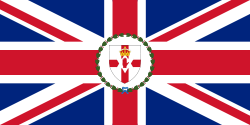Governor of Northern Ireland
| Governor of Northern Ireland | |
|---|---|
|
Flag of the Governor of Northern Ireland | |
| Style | Excellency |
| Residence | Hillsborough Castle |
| Appointer | British Monarch |
| Precursor | Lord Lieutenant of Ireland |
| Formation | 9 December 1922 |
| First holder | The 3rd Duke of Abercorn |
| Final holder | The Baron Grey of Naunton |
| Abolished | 18 July 1973 |
| Succession | Secretary of State for Northern Ireland |
The Governor of Northern Ireland was the principal officer and representative in Northern Ireland of the British monarch. The office was established on 9 December 1922 and abolished on 18 July 1973.
Overview
The office of the Governor of Northern Ireland was established on 9 December 1922 under Letters Patent to:[1]
do and execute in due manner as respects Northern Ireland all things which by virtue of the [1920] Act and our said Letters Patent of 27 April 1921 or otherwise belonged to the office of Lord Lieutenant at the time of the passing of the Irish Free State Constitution Act 1922.
The Governor had possession of the Great Seal of Northern Ireland.
The Governor was the successor to the Lord Lieutenant of Ireland in Northern Ireland, itself established on 3 May 1921.[2] The office of the Governor was abolished on 18 July 1973 under Section 32 of the Northern Ireland Constitution Act 1973.[3] The Secretary of State for Northern Ireland, a cabinet office that had been created in 1972, took over the functions of the Governor on 20 December 1973 under Letters Patent.
Official residence
The official residence of the Governor of Northern Ireland was Hillsborough Castle in County Down. Following refurbishment of the Castle, the Duke of Abercorn took up residence in 1925. It remained the official residence until the abolition of the office of Governor in 1973; henceforth it has been the official residence of the Secretary of State for Northern Ireland.
Governors of Northern Ireland (1922–73)
| № | Governor (Birth–Death) |
Portrait | Tenure | Monarch | Prime Minister | |
|---|---|---|---|---|---|---|
| Took office | Left office | |||||
| 1 | The 3rd Duke of Abercorn (1869–1953) |
 |
12 December 1922 | 6 September 1945 | George V Edward VIII George VI |
The 1st Viscount Craigavon Andrews The 1st Viscount Brookeborough |
| 2 | The 4th Earl Granville (1880–1953) |
 |
7 September 1945 | 1 December 1952 | George VI Elizabeth II |
The 1st Viscount Brookeborough |
| 3 | The 2nd Baron Wakehurst (1895–1970) |
 |
1 December 1952 | 1 December 1964 | Elizabeth II | The 1st Viscount Brookeborough O'Neill |
| 4 | The 1st Baron Erskine of Rerrick (1893–1980) |
 |
1 December 1964 | 27 November 1968 | Elizabeth II | O'Neill |
| 5 | The Baron Grey of Naunton (1910–1999) |
 |
27 November 1968 | 26 June 1973 | Elizabeth II | O'Neill Chichester-Clark Faulkner |
See also
References
- ↑ House of Lords, Northern Ireland Bill, Memorandum by the Northern Ireland Office.
- ↑ 3 May 1921 was the "appointed day" under the Government of Ireland Act 1920, upon which the Parliaments of Northern Ireland and Southern Ireland were established,(SR&O 1921, No. 533).
- ↑ A New History of Ireland by Theodore William Moody, Francis John.
